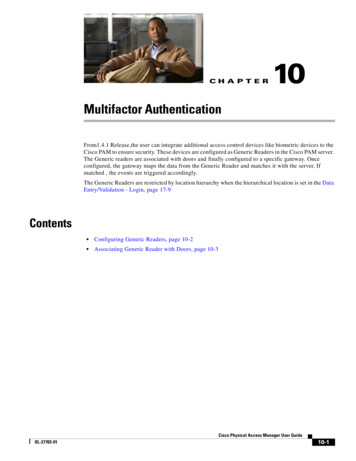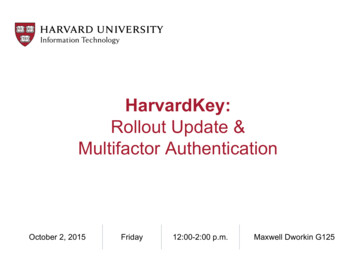
Transcription
CH A P T E R10Multifactor AuthenticationFrom1.4.1 Release,the user can integrate additional access control devices like biometric devices to theCisco PAM to ensure security. These devices are configured as Generic Readers in the Cisco PAM server.The Generic readers are associated with doors and finally configured to a specific gateway. Onceconfigured, the gateway maps the data from the Generic Reader and matches it with the server, Ifmatched , the events are triggered accordingly.The Generic Readers are restricted by location hierarchy when the hierarchical location is set in the DataEntry/Validation - Login, page 17-9Contents Configuring Generic Readers, page 10-2 Associating Generic Reader with Doors, page 10-3Cisco Physical Access Manager User GuideOL-27703-0110-1
Chapter 10Multifactor AuthenticationConfiguring Generic ReadersConfiguring Generic ReadersTo do thisStep 1From the Doors menu, click Generic Readers.Step 2The Generic Reader window opens. Click Add.Enter the following fields: Name (alpha-numeric characters) ID (numeric)Select values in the following drop down lists: Generic reader type Generic reader category Hierarchical locationSelect the ADA enabled radio button.TipEnsure that Name and ID are similar.Cisco Physical Access Manager User Guide10-2OL-27703-01
Chapter 10Multifactor AuthenticationAssociating Generic Reader with DoorsTo do thisStep 3Click Save and Close. The Reader information is listed in the Generic Reader window.NoteOnly users with Admin rights are permitted to configure generic readers.Associating Generic Reader with DoorsTo do thisStep 1From the Doors menu, select Hardware. The gateway drivers, gateways and doors are displayed.Cisco Physical Access Manager User GuideOL-27703-0110-3
Chapter 10Multifactor AuthenticationAssociating Generic Reader with DoorsTo do thisStep 2Select the door and right click to view the drop down menu.Click Associate Generic Reader. AnAssociate Generic reader window opens.Step 3Select the Generic Reader from the list and click OK.The Generic Reader is configured to the door.NoteYou can associate a maximum of six Generic Readers to a door.Cisco Physical Access Manager User Guide10-4OL-27703-01
Chapter 10Multifactor AuthenticationAssociating Generic Reader with DoorsTo do thisStep 4Click Dissociate Generic Reader to remove a reader from the door configuration.NoteStep 5The drop down menu displays the list of generic readers assigned to the door.Right click the door and select Edit. The Edit Door window opens. Select Properties to view theGeneric Readers added to the door and the Multifactor Authentication timer (sec). You can edit thetimer and set the time.NoteThe default value of Multifactor Authentication timer (sec) is 10 seconds.Cisco Physical Access Manager User GuideOL-27703-0110-5
Chapter 10Multifactor AuthenticationAssociating Generic Reader with DoorsNoteNote The generic readers configured by the cpamadmin is not restricted to any hierarchical location. When a location-restricted user creates a generic reader, the hierarchical location field isauto-populated. The location-restricted users can access only devices (generic readers) of their location and theevents for these devices alone is populated for them.These points are applicable only when the Profile enhancement feature is set in the System Configurationof the Cisco PAM. Otherwise the Cisco PAM appliance retains its behavior as in the previous version(1.3).Additional InformationMultifactor authentication depends on the external system to authenticate biometric or facial data thatthe Cisco PAM receives from the generic reader. The Cisco PAM does not claim support to authenticatethe received data. The gateway authenticates the data based on the badge swipe by the user and HTTPSMFA requests it receives from external devices configured as generic readers in Cisco PAM.The External system must send the following HTTPS request for establishing a session with GWFor example:POST /fcgi/user.login?login HTTP/1.1Accept: image/gif, image/x-xbitmap, image/jpeg, image/pjpeg, sdocument, application/xaml xml, application/x-ms-xbap,application/vnd.ms-excel, application/vnd.ms-powerpoint, application/msword, */*User-Agent: Mozilla/4.0 (compatible; MSIE 7.0; Windows NT 5.1; .NET CLR 1.1.4322; .NET CLR2.0.50727)Host: 10.78.179.95Content-Length: 48Content-Type: application/x-www-form-urlencodedAccept-Language: en-auCache-Control: no-cacheusername gwadmin&password Cisco123&TRACKID 12345The External system after authenticating the biometric data must send the following HTTPS request toGWFor example:POST /fcgi/webmgr.ac?post generic rdr event HTTP/1.1Accept: image/gif, image/x-xbitmap, image/jpeg, image/pjpeg, sdocument, application/xaml xml, application/x-ms-xbap,application/vnd.ms-excel, application/vnd.ms-powerpoint, application/msword, */*User-Agent: Mozilla/4.0 (compatible; MSIE 7.0; Windows NT 5.1; .NET CLR 1.1.4322; .NET CLR2.0.50727)Host: 10.78.179.95Content-Length: 59Content-Type: application/x-www-form-urlencodedAccept-Language: en-auCache-Control: no-cachehibadge 0&lobadge 34959&Generic Reader id GR1&TRACKID 12345Cisco Physical Access Manager User Guide10-6OL-27703-01
Chapter 10Multifactor AuthenticationAssociating Generic Reader with Doorswhere,TRACKID — user defined cookiehibadgeq—higher 32 bits of a badge (badge supports max of 64 bits)lobadge—lower 32 bits of a badgeGeneric Reader id—ID of the generic reader as configured under the Generic Reader Module.Cisco Physical Access Manager User GuideOL-27703-0110-7
Chapter 10Multifactor AuthenticationAssociating Generic Reader with DoorsCisco Physical Access Manager User Guide10-8OL-27703-01
10-5 Cisco Physical Access Manager User Guide OL-27703-01 Chapter 10 Multifactor Authentication Associating Generic Reader with Doors Step 4 Click Dissociate Generic Reader to remove a reader from the door configuration. Note The drop down menu displays the list of generic readers assigned to the door. Step 5 Right click the door and select Edit. The Edit Door window opens.










